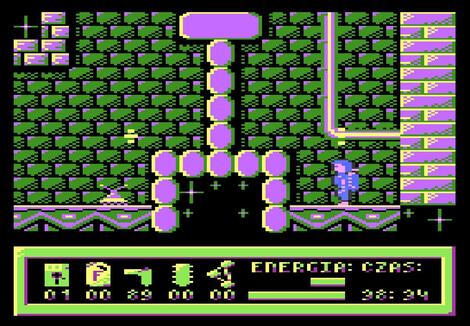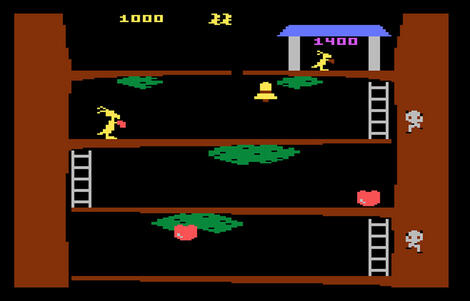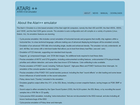Thomas Richter opublikował nową wersję ATARI++ - emulatora małych ATARI dla linuxa,i dla Windowsów. Plusy w nazwie są nie od parady, emulator posiada zaktualizowaną wersję Basica i OS'a, poprawiające co grubsze błędy ze starych czasów i przyśpieszające pracę oprogramowania.
Atari++ 1.8.0
- - Atari++ has now a built-in Basic interpreter, namely Basic++. It is a mildly extended Atari Basic dialect, which is quite a bit faster, plus
- one additional command, "DIR". See the Basic++ distribution for additional modifications.
- - The Basic settings have been improved, the preferences allow now up to three Basic images to be defined, typically corresponding to revisions A,B and C of the language.
- The CPU emulation fixed the cycle count for some rarely used instructions.
- Added a profiler to the monitor. PROF.S starts the profiler. PROF.L lists the profile counts collected so far, PROF.C lists the cumulative cycle counts of subroutines.
- Tape emulation has been largely extended and simplified. Entering a non-existing tape will now create an error immediately. The tape emulation also allows now WAV files, i.e. digitized real tapes, and will decode them on demand. Output to .WAV files (audio-encoding) is now also possible. This integrates the wav2cas and cas2wav programs of the same author into the emulator.
- SIO sound emulation has been extended. The SIO sound now also emulates the tape sound on input, and improves on the authenticity of the disk drive sound.
- The X11 front end improves the handling of mouse clicks. Mouse clicks that do not go into the window but into an overlapping window are now ignored.
- Audio outut can now be recorded into a SAP Record-Type R file for playback.
- Disk drive emulation has been largely improved. Several drive types are now emulated, including their serial transfer characteristics, such as disk drive speed. Note that the original 1050 drive emulation no longer takes disks that are double density or have more sectors than those of the original disk formats. To play such extended disks, select one of the more advanced drive types.
- SIO emulation has been reworked to some degree to allow the extended drive types, control the serial speed and allow for proper tape emulation.
- Binary disk images now also create a valid disk structure containing the load file as AUTORUN.SYS so it can be loaded from DOS, too.
- The math pack patch has been revised and its precision has been inproved by changing the rounding policy slighty. The floating point to ASCII conversion now also follows the convention of the original math pack.
- Detection of .BAS (Basic) files as disk images is now handled more carefully, and the emulator will no longer confuse some xfd disk images with basic files.
- The built-in monitor supports now symbolic labels. Such label information can be read from a CA65 debug file output, i.e. use --dbgfile on the ca65 command line. The debug file is then read with the new ENVI.S command of the monitor.
- The math pack in the built-in Os ROM had a bug in the BCD to ASCII conversion which could not print signed zeros and some denormalized numbers correctly. This got fixed.
- The math pack could not handle signed zeros in the BCD to integer conversion, fixed.
- The BCD to integer conversion was pretty slow. The new release replaces the algorithm completely, making it a lot faster.
→ NOWSZY [ATARI] Atari++ 1.8.2
Atari++ 1.82 28/03/2020
- Release of Atari++, the portable atari emulator for Linux and windows. This is a bug-fix release that does not include major new features, but includes a fixed ATX support, a new version of Basic++, namely 1.08, and improved artifact rendering.
→ NOWSZY [ATARI] Atari++ 1.8.1
Atari++ 1.81 12/15/16
- Fixed a bug in SIO that prevented correct emulation with the SIO patch enabled.
- Fixed a timing issue in the SIO emulation that sometimes returned a command acknowledge too early for the ROM codes to react.
- Fixed a minor bug in the Pokey SIO sound emulation of SIO.
- Fixed the command handling of the USDoubler disk drive emulation.
- Updated Os++, the build-in operating system. A bug in the screen-handler prevented that the screen goes back to the editor in case an already established text window is closed by a screen-open command.
- Minor cleanup in the command line of the built-in Dos of Os++.
- Updated Basic++ to the latest version 1.06.
→ [ATARI] Atari++ 1.7.3
Atari++ 1.7.3
- Added emulation support for the tape drive, and .CAS files loaded into the tape. Raw audio files in the .WAV format are not supported by the emulator directly, but two external programs "wav2cas" and "cas2wav" can convert between them.
- Added an additional rendering mode for the X11 video system of Linux machines. Instead of drawing the emulated screen on the display rectangle by rectangle, the "xvideo" mode uses the xv extension of X11 to render into an off-screen memory which is then merged into the screen by the video overlay mechanis of the hardware. This rendering mode may create a smoother display and may improve performance on lower end hardware, but is not necessarilyavailable everywhere.
- A complete manual of Os++, including a memory map, is now available as download.
- Included the Os++ system disk, including disk-based utilities around Os++ including a Dos overlay manager that relocates Dos buffers behind the cartridge, an RS232 handler, an updated version of DISKIO, a disk-based tape handler, a menu based DUP and a lot of tools.
→ [ATARI] Atari++ 1.7.2 Edycja Wielkanocna
Atari++ 1.7.2
a new release of Atari++, the portable atari emulator for Linux and windows has been released here in the download section - as usual, you find there the Linux sources and a compiled version for 32-bit Windows. Release 1.72 fixes a couple of nasty little bugs that were overlooked, but the main new feature is the support of ATX images, plus many small changes to Os++, the included operating system for the 8-bits.
- The binary file loader automatically generated when inserting a COM or EXE into the disk drive and booting from it is now much shorter and requires a lot less RAM. It requires now, however, an additional ESCape code and hence emulator support. This will now also load binary files that require RAM from 0x800 and up.
- This release adds support for ATX files and includes an emulation of the disk drive timing, handling of bad and duplicate sectors and a more precise emulation of the SIO timing.
- An additional type of watch point was added: The default watch point now only reacts on memory writes, whereas the new watch point continues to react on reads and writes.
- Experimented a lot with the timing of the GTIA Prior writing and found that the currently implemented logic is actually very close to the real system, additional delay cycles make results only worse, not better. Thus, leaving it as it is right now.
- The SDL StringGadget now reacts on Ctrl+Backspace and Ctrl+Delete and erases its contents on this keyboard command.
- Added emulation for "stuck" Player/Missile shift registers when switching from 4x or 2x expansion to the size register "2" value, which is almost, but not quite 1x expansion.
- The built-in Os blocks NMIs now early in the reset cycle and by that tries to work around bad display lists left over by buggy programs.
- Minor modification in the built-in FMS (Dos 2.++): CONFIG.SYS can now change the position of the FMS buffers by poking into DiskBufferBase $710,$711 and relocate them.
- Minor modification of the short VBI: GPrior, ColBK and Col1 are now only reloaded if the graphics mode really requires it. This applies to fine scrolling text modes, and the text window modes with the GTIA modes (modes 9+64,10+64 and 11+64). This fixes compatibility issues with Atari Tennis and some Lucasfilms intros.
- Minor modifications in the FMS: Rename with wildcard was broken, and the FMS no longer tries to load non-valid VTOCs.
- The DUP COPY command avoids now trying to overwrite BASIC program memory or other user memory protected correctly by setting APPMEMHI. Some cartridges do not set this Os pointer correctly, though. Mac/65 does not. The new DUP command NEW will erase user memory and make it available for COPY.
- Fixed a long standing bug of all Dos 2.XX compatible FMS'es: Directory reading mode did not cooperate with any other operations that would access the directory, and would invalidate the directory access channel. This is no longer the case now. Additionally, reading the directory sets now the EOF warning flag (Y = 3) correctly right before the EOF.
- The STATUS command, as specified by DOS 2.0S and DOS 2.5, was actually quite unuseful as it required a file specification which was never supplied by BASIC. The new implementation returns the status of the last CIO command on the same channel if the channel is open, allowing BASIC for example to access the near-EOF warning return code.
- Antic DMACtrl in-line adjustment tricks are not supported, neither any HScroll adjustments to disable the DMA-stop.
- Bus noise picked up by GTIA if GRACTL is enabled but DMACTL is disabled is currently not emulated correctly.
- Bus noise picked up by ANTIC on the right side of wide playfield screens is currently not emulated at all (and neither visible if it would).
- The POKEY soft-reset cylce is currently not emulated completely.
- Bit-banging serial output is currently not emulated at all.
→ [ATARI] Atari++ 1.7.1
Atari++ 1.7.1
- The release how 1.70 should have been, but wasn't due to time constraints. Lots of fixes left over from 1.70 are now integrated, and regressions have been fixed:
- The ANTIC logic to roll over an instruction to the next scan was partially broken and also rolled a "Jump on Vertical Blank" over, breaking some games that played tricks with the DMA control register.
- The new CPU logic to fetch the wrong interrupt vector (NMI instead of IRQ) was partially broken and forgot to fetch the right high-bit, potentially breaking code.
- The 65C02 BRK instruction was emulated incorrectly. The NMOS version worked fine, and continues to work fine.
- 1.70 had, as indicated, a regression for late writes on Antic CHARCTL that broke at least one game ("Summer Games"). The corresponding logic has been re-done in a much cleaner way and is now part of 1.71.
- Pokey lo-byte timer registers in a 16-bit timer pair did not underrun to 255 correctly. In fact, the timer emulation was partially re-done and should now do correctly, including the relative offset of low and high-timer on a STIMER resynchronization.
- GTIA priority logic for player 4 on top of playfield 0/1 was broken in one priority selection, which got fixed now.
- Player/missile retriggering was partially incorrect. This has been fixed now.
- Player/missile resizing was, as stated, experimental in 1.70 and is now implemented correctly.
- On-line player/missile shape changes are now experimentally supported.
- The ANTIC/CPU WSYNC logic was partially broken as it does not block writes, only reads - the mechanism is a different one. Note that this only holds for the NMOS version. The CMOS version works correctly. This is also emulated.
- The NMI/IRQ reaction times were short by one cycle. They are now 7 cycles as indicated.
- GTIA mode 80 on top of a low-res screen created a wrong color for the PF3:BK pixel combination. This got fixed.
- GTIA VDelay support was partially broken. Actually, the P/M DMA engine was redesigned for this release and should now work correctly.
- Alsa sound support was broken on some hardware. For some Alsa drivers, audio hardware reacts allergic when trying to fill more samples into the available buffer, stalling the main program. The updated Alsa sound support rounds the samples written to the Alsa buffer to entire fragment sizes avoiding this problem. The SDL or Oss/HQOss drivers were not affected, though in general Alsa is preferably.
Anti-News: (or, what does not yet work):
- P/M shape changes are currently supported experimentally until I get hands on real hardware.
- P/M shift-register disable tricks with PSIZE=2 are currently not supported.
- Writes to GTIA color or priority registers are not delayed and happen immediately. The same goes to many other registers in Pokey, Antic and PIA.
- Antic DMACtrl in-line adjustment tricks are not supported, neither any HScroll adjustments to disable the DMA-stop.
- Bus noise picked up by GTIA if GRACTL is enabled but DMACTL is disabled is currently not emulated correctly.
- Bus noise picked up by ANTIC on the right side of wide playfield screens is currently not emulated at all (and neither visible if it would).
- The POKEY soft-reset cylce is currently not emulated completely.
- Bit-banging serial output is currently not emulated at all.
→ [ATARI] Atari++ 1.7.0
Its emulation features are stunning:
- Cycle precise emulation; this includes correct emulation of horizontal kernels and programs that modify chip registers within a horizontal line. In a less technical language, software making use of advanced displaying techniques will be emulated correctly.
- Emulation of an advanced 1050 disk drive including single, double and enhanced density. The emulator not only understands .atr and .xfd files, but comes with a mini-boot loader that allows you to boot from binary load files (.exe and .com).
- Supports .gz compressed images, and .DCM disk images. No additional tools required to load these disks.
- Precise emulation of ANTIC and GTIA graphics, including undocumented scrolling features, undocumented GTIA player/missile priorities and collision detection, and some other less known GTIA features. Color artifacting is also available.
- Precise emulaton of POKEY sound, including "Software Speech", high-pass filters and POKEY hardware timer interrupts. An emulation of the console speaker is also included.
- Precise emulation of the POKEY SIO (serial transfer) protocol, including the Atari "sound effects" on disk loading and some lesser known influences of serial transfer on the sound subsystem.
- Pokey stereo hack ("Gumby") included in the emulation.
- Emulates graphics output either thru X11, or the SDL library, including a screen snapshot feature, saving images as PGM, BMP or PNG.
- Sound output is either emulated by the Open Sound System (OSS), the ALSA system, the SDL library, or by recording the sound samples into a WAV file in CD quality.
- Cylce-precise 6502 emulation, including "extra-instructions" that are not documented in the 6502-manual, and also including all known hardware-bugs of the 6502.
- Cylce-precise emulation of Pokey timer and interrupts.
- Printer emulation thru standard LPR printer user interface.
- Flicker-Fixer option for games that toggle palettes fast for more colors.
- Emulation of color artifacts due to PAL color subsampling
- Optional de-blocking filter for magnified output
- Built-in Os emulation
- Joystick, paddle and lightpen emulation by keyboard or mouse, or by standard analogue PC joysticks. A special home-made interface allows the connection of Atari digital joysticks by an additional joystick driver. Hence, you'll be able to play all your old games even with your digital joysticks.
- Includes emulation of the Pokey POT reading mechanism.
- Saves and loads machine states to save games in the middle of the game play, and allows to resume from that point later on.
- Includes emulation of a variety of cartridge types, including 5200 games cartridges and Oss supercarts.
- Effective emulation of 800XL/XE and cartridge bank-switching mechanisms.
- Emulation of the Atari 850 Interface box by the serial port of the host computer, including a full 850 driver "in ROM".
- Interfaces to "Hias'" AtariSIO driver, allowing you to connect real Atari hardware to the PC.
- Includes a Dos 2.xx compatible interface to the filing system of the emulator.
- Easy to use graphical user front-end for simple setup and configuration, includes saving and loading of (human-readable) configuration files. The user front-end also allows to setup details like the player/missile collision setup to build "game-trainers" on demand.
- Includes a built-in monitor allowing experts to debug Atari software easily.
- And the best: It is free.

![[ATARI] Atari++ 1.8.0](/Photos/www/picphoto/ed6795961.jpg,134)


 The Atari++ Emulator is a Unix based emulator of the Atari eight bit computers, namely the Atari 400 and 800, the Atari 400XL, 800XL and 130XE, and the Atari 5200 game console. The emulator is auto-configurable and will compile on a variety of systems (Linux, Solaris, Irix). Its emulation features are stunning:
The Atari++ Emulator is a Unix based emulator of the Atari eight bit computers, namely the Atari 400 and 800, the Atari 400XL, 800XL and 130XE, and the Atari 5200 game console. The emulator is auto-configurable and will compile on a variety of systems (Linux, Solaris, Irix). Its emulation features are stunning: